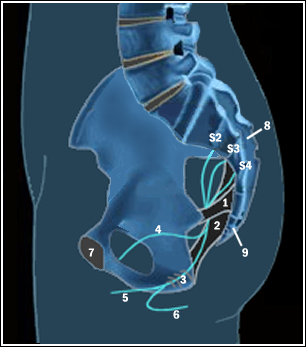Site d'information sur la Névralgie pudendale

1. ligament Sacro-épineux; 2. Ligament Sacro-tubéreux; 3. Canal d'Alcock(canal pudendal); 4. Nerf dorsal du clitoris (verge); 5. Branche périnéale du nerf pudendal ; 6. Branche anale du nerf pudendal; 7. Os du pubis; 8. Sacrum; 9. Coccyx; S2, S3 et S4 : Racine sacrée formant le nerf pudendal
To really understand the mechanisms and the causes of pudendal neuralgia, it’s important to know the complex route taken by this nerve.
The scene takes place in the pelvis. This nerve is called sacred because it originates behind the sacrum. Its main branch comes from the third sacred hole (S3) and is completed by its sister roots (S2 and S4).
Please note that S1 and S5 can also contribute. Immediately at the exit, they go under the pyriforme muscle.
Afterwards, at the level of the sacro-epineux (n°1), these nerves merge together to make one, called the pudendal nerve. It goes through the ligament n°1 and the ligament sacro-tuberal (n°2) that create a ligament clip, to go into the aponevrose split of the internal obturator muscle called Alcock canal or pudendal canal (n°3). It’s in this canal that 3 main branches will start from the pudendal nerve: the dorsal nerve of the clitoris (or penis), the perineum nerve and the inferior rectal nerve. These nerves will both partially and completely innervate the urethra and anal sphincters, the perineum muscles and the genital organs.
This is the anatomical description of a normal and healthy pudendal nerve. In the case of pudendal neuralgia, the nerve is submitted to one or several compressions along its course, which with time irritates and damages it.
Traduction : Mme Patricia Pellizza
Reproduction interdite sous peine de poursuite judiciaire
Article L.111-1 du code de la propriété intellectuelle
Copyright : Droits d'auteur déposés
Wilwebm@ster : Logiciels gratuits - Ecran de veille gratuit - Annuaire peinture - logiciel dessin gratuit - Logiciel dessin caricature - Névralgie - forum névralgie - Publication médicale - syndrome fibromyalgie - Douleurs pelviennes - Pudendal neuralgia - Pudendal nerve - Electromyographie - Centre anti-douleur - Mésothérapie - Chiropracteur - Sophrologue - Fasciathérapie - Etiopathie - Prostatite - Maladie de Lyme - Scarlatine - Panaris - Orgelet - Tracheite - Hyperthyroidie - Acupuncteur - Hypnotherapeute - Angiome
Contacter le webmaster - Mentions légales - Régles de confidentialité